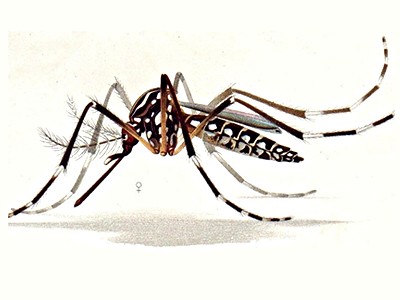USU's Institute for Antiviral Research Investigating Zika Virus Treatments
Associate Research Professor Justin Julander leads research efforts on the Zita virus at USU's Institute for Antiviral Research.
Scientists at Utah State University’s Institute for Antiviral Research (IAR) are doing some of the first antiviral treatment trials in the United States aimed at identifying and testing compounds that may be effective in treating or preventing Zika virus infections.
Under the direction of Associate Research Professor Justin Julander, with funding from the National Institutes of Health, experiments with Zika virus have been underway at USU since last December. The USU researchers noted an upswing in reported cases early last year and mentioned to their project officer at the NIH that Zika might be added to a contract to investigate possible treatments for this emerging pathogen.
Work is being done in cell culture first to determine whether some compounds that have shown promise in fighting related viruses — specifically, dengue and yellow fever — may be used to fight Zika. The most effective ones will then be tested in animal models. Zika virus is categorized a Biosafety Level 2 agent by the Centers for Disease Control and Prevention because is cannot be spread through the air and typically causes only mild disease. The IAR is handling the virus with more stringent Level 3 protocols as an extra precaution for lab technicians’ safety.
Julander said there are several challenges related to fighting Zika virus which is primarily spread by Aedes aegypti mosquitos. There are currently cases being investigated that may show the virus can also be sexually transmitted.
More than 80 percent of people who get the virus have no symptoms or develop only mild illness. Key in fighting most viral infections is starting treatment while the body’s viral load is small.
“No one is going to go to the doctor because they got a mosquito bite,” Julander said. “So by the time someone feels symptoms the virus has had time to become established. Ideally we need a vaccine to protect against the virus and a way to treat the virus at an advanced stage.”
Another troublesome trait of viruses is that they rely on a host’s cellular machinery to complete their lifecycle. Effective treatments must hit the virus and not damage the host’s cells. If the IAR has good results with compounds in cell culture and animal models it will be up to those who synthesized the compound to initiate clinical trials.
“One benefit of doing this work at a research university is that we don’t constantly have to think about profitability and the bottom line,” Julander said. “Clinical trials are very expensive to run. That’s one of the reasons developing new drugs costs millions and millions of dollars.”
The cost means that companies look for drugs that will be commercially viable and though Zika virus was identified back in 1947, it has not fit that criteria. The tropical mosquito that carries the virus has a limited range and the virus hasn’t made people very sick. If they do develop illness it is acute but not chronic, and the body eventually clears the virus. Now though, recent and unprecedented outbreaks in South America and possible links to microcephaly have heightened international interest.
It is possible, Julander said, that Zika virus has changed in a way that is giving it a new advantage in spreading more broadly and causing more problems. In the United States the Aedes aegypti mosquito is found only the southernmost areas. However, last year’s worldwide chikungunya virus outbreak occurred because another mosquito species that ranges farther north now carries the virus.
“The Institute for Antiviral Research tries to respond to important concerns and find ways to prevent or treat them,” Julander said. “That is our mission, our goal. And though the work we do takes time, we can be rapid responders to viral disease outbreaks.”
The composition of the staff has changed over the years since the institute’s founding in 1978. Currently seven faculty members in USU’s Department of Animal, Dairy and Veterinary Sciences make up the IAR staff, along with a team of graduate and undergraduate student technicians. The group has been involved in research on SARS, HIV, influenza, West Nile Virus, Dengue and yellow fever and last fall surpassed a funding landmark of more than $100 million in contracts and grants over the IAR’s lifetime.
Related links:
- KLS-TV news
- Utah Public Radio
- USU Institute for Antiviral Research
- USU Department of Animal, Dairy and Veterinary Sciences
- USU College of Agriculture and Applied Sciences
Contact: Justin Julander, Justin.Julander@usu.edu
Writer: Lynnette Harris, 435-797-2189, Lynnette.Harris@usu.edu
The Zika virus is primarily spread by Aedes aegypti mosquitos.
Graduate technician Joseph Evans in the lab.
A KSL-TV cameraman at work with graduate technician Makda Gebre.
(map from the Centers for Disease Control website) Countries and Territories in the Americas with active Zika virus transmission.
TOPICS
Research 881stories Vet Sciences 63stories Disease 51stories Virus 23storiesComments and questions regarding this article may be directed to the contact person listed on this page.

.jpg)












